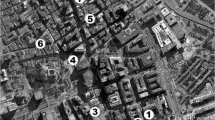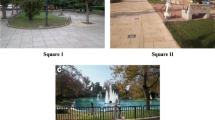Abstract
To understand thermal preferences and to define a preliminary outdoor comfort range for the local population of Glasgow, UK, an extensive series of measurements and surveys was carried out during 19 monitoring campaigns from winter through summer 2011 at six different monitoring points in pedestrian areas of downtown Glasgow. For data collection, a Davis Vantage Pro2 weather station equipped with temperature and humidity sensors, cup anemometer with wind vane, silicon pyranometer and globe thermometer was employed. Predictions of the outdoor thermal index PET (physiologically equivalent temperature) correlated closely to the actual thermal votes of respondents. Using concurrent measurements from a second Davis Vantage Pro2 weather station placed in a rural setting approximately 15 km from the urban area, comparisons were drawn with regard to daytime thermal comfort levels and urban–rural temperature differences (∆Tu-r) for the various sites. The urban sites exhibited a consistent lower level of thermal discomfort during daytime. No discernible effect of urban form attributes in terms of the sky-view factor were observed on ∆Tu-r or on the relative difference of the adjusted predicted percentage of dissatisfied (PPD*).






Similar content being viewed by others
Notes
For determination of the SVF, fisheye images at each monitoring point were generated using a fisheye lens FC-E8 coupled to a Nikon CoolPix 4500 digital camera. From the fisheye images, SVF was calculated using Rayman, a public domain software developed by Andreas Matzarakis (http://www.mif.uni-freiburg.de/RayMan/).
Table A.1, Annex A, ISO 9920 (ISO 2007).
Accounting for a population of approximately 600,000 inhabitants (Glasgow), with a margin of error of 5 %, confidence level 95 % and response distribution of 33 % (comfort, discomfort due to cold or discomfort due to heat), a minimum of 340 respondents would be required.
According to ISO 8996 (ISO 1990), an average man is 30 years old, weighs 70 kg and is 1.75 m tall; the average woman is 30 years old, weighs 60 kg and is 1.70 m tall.
Table 2 of ISO 7730 shows three possible thresholds for the definition of the acceptable percentage of persons in thermal discomfort: TS = 0; −1 ≤ TS ≤ +1; −2 ≤ TS ≤ +2, the choice lying with the second threshold. Thus, comfortable conditions correspond to a maximum of 10 % dissatisfied.
According to ISO 8996 (ISO 1990), an average man is 30 years old, weighs 70 kg and is 1.75 tall.
References
Ali-Toudert F, Mayer H (2006) Numerical study on the effects of aspect ratio and orientation of an urban street canyon on outdoor thermal comfort in hot and dry climate. Build Environ 41:94–108
ANSI/ASHRAE (2004) Thermal Environmental Conditions for Human Occupancy (ANSI Approved). American Society of Heating, Refrigerating, and Air-Conditioning Engineers. Standard 55
Chrisomallidou N, Chrisomallidis M, Theodosiou T (2004) Design principles and applications. In: Nikolopoulou M (ed) Designing open spaces in the urban environment: a bioclimatic approach. CRES, Greece
de Dear RJ, Fountain ME (1994) Field experiments on occupant comfort and office thermal environments in a hot-humid climate. ASHRAE Transactions 100:457–474
Eliasson I, Knez I, Westerberg U, Thorsson S, Lindberg F (2007) Climate and behaviour in a Nordic city. Landscape Urban Plan 82:72–84
Emmanuel R (2005) An urban approach to climate-sensitive design. Spon, London/New York
Emmanuel R, Krüger E (2012) Urban Heat Island and its impact on climate change resilience in a shrinking city: the case of Glasgow, UK. Build Environ 53:137–149. doi:10.1016/j.buildenv.2012.01.020
Erell E, Pearlmutter D, Williamson T (2011) Designing the spaces between buildings. Earthscan, London
Givoni B (1998) Climate considerations in building and urban design. Van Nostrand Reinhold, New York
Hassid S, Santamouris M, Papanikolaou N, Linardi A, Georgakis C, Assimakopoulos DN (2000) The effect of the Athens heat island on air conditioning load. Energ Buildings 32:131–141
Höppe P (1999) The physiological equivalent temperature—a universal index for the biometeorological assessment of the thermal environment. Int J Biometeorol 43(2):71–75
Höppe P (2002) Different aspects of assessing indoor and outdoor thermal comfort. Energ Buildings 34:661–665
ISO (1995) ISO 10551. Ergonomics of the thermal environment—assessment of the influence of the thermal environment using subjective judgement scales. ISO, Geneva
ISO (1998) ISO 7726. Ergonomics of the thermal environment—instruments for measuring physical quantities. ISO, Geneva
ISO (1994) ISO 7730. Moderate thermal environments — determination of the PMV and PPD indices and specification of the conditions for thermal comfort. ISO, Geneva
ISO (2007) ISO 9920. Ergonomics of the thermal environment – estimation of the thermal insulation and evaporative resistance of a clothing ensemble. ISO, Geneva
ISO (1990) ISO 8996. Metabolic heat production. 2.2 Ergonomics—determination of metabolic heat production. ISO, Geneva.
Johansson E (2006) Urban design and outdoor thermal comfort in warm climates. PhD Thesis, Lund University.
Johansson E, Emmanuel R (2006) The influence of urban design on outdoor thermal comfort in the hot, humid city of Colombo, Sri Lanka. Int J Biometeorol 51:119–133. doi:10.1007/s00484-006-0047-6
Katzschner L (2005) The contribution of urban climate studies to a new urbanity. Proceedings of the 8th Encontro Nacional de Conforto no Ambiente Construído. Maceió: ANTAC.
Knez I, Thorsson S (2006) Influence of culture and environmental attitude on thermal, emotional and perceptual evaluations of a public square. Int J Biometeorol 50:258–268. doi:10.1007/s00484-006-0024-0
Kolokotroni M, Zhang Y, Watkins R (2007) The London Heat Island and building cooling design. Solar Energy 81(1):102–110
Krüger E, Minella FO, Rasia F (2011) Impact of urban geometry on outdoor thermal comfort and air quality from field measurements in Curitiba, Brazil. Build Environ 46(3):621–634
Krüger E, Bröde P, Emmanuel R, Fiala D (2012) In: Windsor Conference 2012 (ed) The changing context of comfort in an unpredictable world. Conference program. NCEUB, London, UK, Predicting outdoor thermal sensation from two field studies in Curitiba, Brazil and Glasgow, UK using the Universal Thermal Climate Index (UTCI)
Matzarakis A, Mayer H, Iziomon MG (1999) Applications of a universal thermal index: physiological equivalent temperature. Int J Biometeorol 43:76–84
UK Met Office (2012) Monthly and annual average climate data at 5 km resolution. http://www.metoffice.gov.uk/climate/uk/stationdata/. Accessed 10 June 2012
Ng E (2009) Policies and technical guidelines for urban planning of high-density cities—air ventilation assessment (AVA) of Hong Kong. Build Environ 44:1478–1488
Nicol F, Humphreys M, Roaf S (2012) Adaptive thermal comfort—principles and practice. Routledge, New York
Nikolopoulou M, Steemers K (2003) Thermal comfort and psychological adaptation as a guide for designing urban spaces. Energ Buildings 3:227–235. doi:10.1016/S0378-7788(02)00084-1
Nikolopoulou M, Baker N, Steemers K (1999) Improvements to the globe thermometer for outdoor use. Archit Science Review 42(1):27–34. doi:10.1080/00038628.1999.9696845
Nikolopoulou M, Baker N, Steemers K (2001) Thermal comfort in outdoor urban spaces: understanding the human parameter. Sol Energy. doi:10.1016/S0038-092X(00)00093-1
Panogopoulos T (2008) Using microclimatic landscape design to create thermal comfort and energy efficiency, In: Proceedings of the 1st Conferência sobre Edifícios Eficientes. Algarve, Portugal
Picot X (2004) Thermal comfort in urban spaces: impact of vegetation growth. Case study: Piazza della Scienza, Milan, Italy. Energ Buildings 36:329–334
Shashua-Bar L, Hoffman ME (2000) Vegetation as a climatic component in the design of an urban street An empirical model for predicting the cooling effect of urban green areas with trees. Energ Buildings 31:221–235
Souza LCL (2007) Thermal environment as a parameter for urban planning. Energy Sustainable Development XI 4:44–53
Spagnolo J, de Dear R (2003) A field study of thermal comfort in outdoor and semi-outdoor environments in subtropical Sydney Australia. Build Env 38:721–738. doi:10.1016/S0360-1323(02)00209-3
Stewart ID, Oke TR (2009) A new classification system for urban climate sites. Bull Am Meteorol Soc 90:922–923
Svensson MK (2004) Sky view factor analysis—implications for urban air temperature differences. Meteorol Appl 11:201–211
Svensson MK, Thorsson S, Lindqvist S (2003) A geographical information system model for creating bioclimatic maps—examples from a high, mid-latitude city. Int J Biometeorol 47:102–112
Thorsson S, Lindqvist M, Lindqvist S (2004) Thermal bioclimatic conditions and patterns of behaviour in an urban park in Göteborg, Sweden. Int J Biometeorol 48:149–156. doi:10.1007/s00484-003-0189-8
Thorsson S, Lindberg F, Eliasson I, Holmer B (2007) Different methods for estimating the mean radiant temperature in an outdoor urban setting. Int J Climatol 27:1983–1993
Thorsson S, Lindberg F, Bjorklund J, Holmer B, Rayner D (2010) Potential changes in outdoor thermal comfort conditions in Gothenburg, Sweden due to climate change: the influence of urban geometry. Int J Climatol 31:324–335
Unger J (2004) Intra-urban relationship between surface geometry and urban heat island: review and new approach. Clim Res 27:253–264
Upmanis H, Chen D (1999) Influence of geographical factors and meteorological variables on nocturnal urban–park temperature differences—a case study of summer 1995 in Göteborg, Sweden. Clim Res 13:125–139
Vanos J, Warland J, Gillespie T, Kenny N (2010) Review of the physiology of human thermal comfort while exercising in urban landscapes and implications for bioclimatic design. Int J Biometeorol 54:319–334
VDI (1998) Methods for the human-biometerological assessment of climate and air hygiene for urban and regional planning. Part I: Climate, VDI guideline 3787. Part 2. Association of German Engineers, Beuthen, Berlin
Voogt J, Krayenhoff ES, Lee I (2011) Urban surface temperatures and urban form. The 18th International Seminar on Urban Form, ISUF 2011, Montreal
Acknowledgements
The financial help provided by the Brazilian funding agencies CNPq and CAPES and instrumentation and analysis facilities provided by the School of Engineering and Built Environment at the Glasgow Caledonian University are gratefully acknowledged.
Author information
Authors and Affiliations
Corresponding author
Rights and permissions
About this article
Cite this article
Krüger, E., Drach, P., Emmanuel, R. et al. Assessment of daytime outdoor comfort levels in and outside the urban area of Glasgow, UK. Int J Biometeorol 57, 521–533 (2013). https://doi.org/10.1007/s00484-012-0578-y
Received:
Revised:
Accepted:
Published:
Issue Date:
DOI: https://doi.org/10.1007/s00484-012-0578-y




